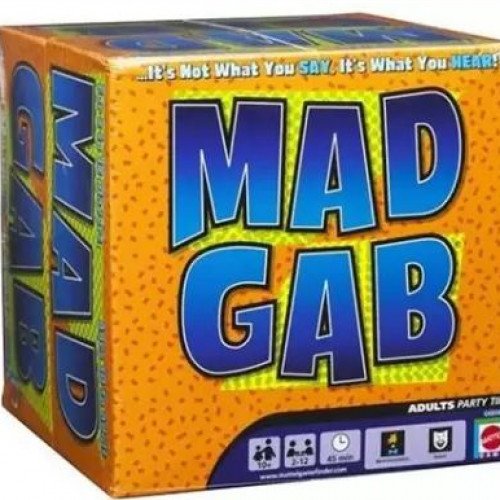MAD GAB VS SHATRANJ

MAD GAB
Mad Gab is a game created by Terry White in which there are at least two teams and 2–12 players. Each team has two minutes to sound out three puzzles. The puzzles, also known as mondegreens, contain small words that, when put together, make a word or phrase. For example, "These If Hill Wore" when pronounced quickly sounds like "The Civil War". Another example would be "Eye Mull of Mush Sheen" quickly spoken it sounds like "I'm A Love Machine". There are two levels of difficulties: easy and hard. The faster the puzzles are answered, the more points the players score. This game uses phonetics, which is a branch of linguistics. This game is a test for the human brain to process sounds based on simpler English-written sounds into a meaningful word or phrase. The game is designed where a person would not be able to decode the meaning of the phrase unless spoken out loud and listened; reading the phrase silently will not allow the player to decode the meaning because sounds would have to be encoded into meaningful English words.
Statistics for this Xoptio

SHATRANJ
Shatranj (Arabic: شطرنج; Persian: شترنج; from Middle Persian chatrang چترنگ) is an old form of chess, as played in the Sasanian Empire. Its origins are in the Indian game of chaturaṅga. Modern chess gradually developed from this game, as it was introduced to the western world by contacts in Muslim Al-Andalus (modern Spain) and in Sicily in the 10th century. The Persian word shatranj ultimately derives from Sanskrit (Sanskrit: चतुरङ्ग; caturaṅga) (catuḥ: "four"; anga: "arm"), referring to the game of the same name: Chaturanga. In Middle Persian the word appears as chatrang, with the 'u' lost due to syncope and the 'a' lost to apocope, such as in the title of the text Mâdayân î chatrang ("Book of Chess") from the 7th century AD. In Persian folk etymology, a Persian text refers to Shah Ardashir I, who ruled from 224–241, as a master of the game: Three books written in Pahlavi, Kar-Namag i Ardashir i Pabagan, Khosrow and ridag, and Wizārišn ī čhatrang ("Treatise on Chess"), also known as the Chatrang Nama ("Book of Chess"), all mention chatrang. In Kār-nāmak it is said that Ardashīr "with the help of the gods became more victorious and experienced than all others in polo, horsemanship, chess, backgammon, and other arts," and in the small treatise on Khosrow and ridag, the latter declares that he is superior to his comrades in chess, backgammon, and hašt pāy. Bozorgmehr, the author of Wizārišn ī čhatrang, describes how the game of chess was sent as a test to Khosrow I (r. 531-79) by the "king of the Hindus Dēvsarm" with the envoy Takhtarītūs and how the test was answered by the vizier Bozorgmehr, who in his turn invented the game Backgammon as a test for the Hindus. These three Middle Persian sources do not give any certain indication of the date when chess was introduced into Persia. The mentions of chess in Kar-Namag i Ardashir i Pabagan and Khosrow and ridag are simply conventional and may easily represent late Sasanian or even post-Sasanian redactions. According to Touraj Daryaee, Kar-Namag i Ardashir i Pabagan is from 6th century. Wizārišn ī čhatrang was written in the 6th century.